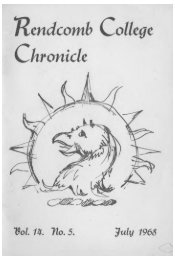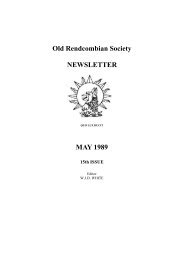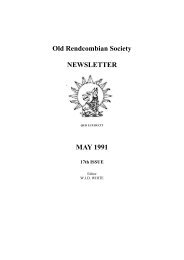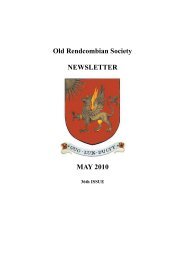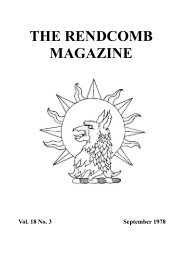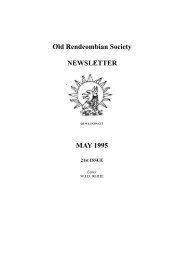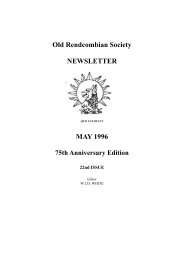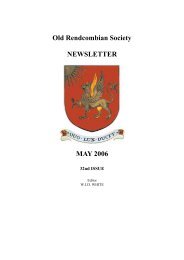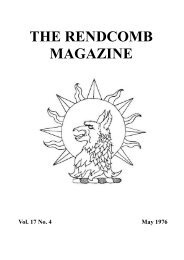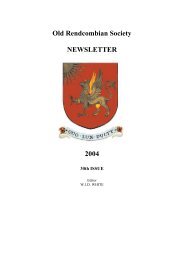The Rendcomb Magazine, May 1975 - The Old Rendcombian
The Rendcomb Magazine, May 1975 - The Old Rendcombian
The Rendcomb Magazine, May 1975 - The Old Rendcombian
- No tags were found...
You also want an ePaper? Increase the reach of your titles
YUMPU automatically turns print PDFs into web optimized ePapers that Google loves.
ANNECY EXCHANGE, 1974LAST summer twelve boys and one girl from <strong>Rendcomb</strong> took part in the Cheltenham-Annecy schools exchange. Everyonepaired up with a French student and then each pair spent three weeks in England and three weeks in France,staying with the families of the host students.<strong>The</strong> trip to Annecy, which is located in the Haute-Savoie, about thirty kilometres from Geneva, was exhausting andchaotic but few people minded as there was a general air of excitement about going on holiday in a foreign country.<strong>The</strong> trip was made doubly pleasant for the <strong>Rendcomb</strong> boys by the presence of approximately five times as many girlsas boys! Age limits stretched from twelve to eighteen and there was a great atmosphere of sociability and friendship.<strong>The</strong> French hosts, once we had arrived in Annecy, were the most generous people I have ever met. <strong>The</strong> beautifulweather and scenery were only surpassed by the friendliness of the people. Great credit is due to the organizers of thescheme and the hard-worked adults who supervised the journeys between Cheltenham and Annecy. I would also liketo thank Mrs. Holdaway for all the hard work which she put into the scheme; I know that I can truthfully say that Annecywas a holiday I will never forget.D.B.THE TURNER EXHIBITIONON Thursday, 30th January, a party of sixth formers were taken to the Turner exhibition at the Royal Academy, London.Upon arrival it was obvious that there was plenty of emphasis on security, and we were initially ushered into thebowels of the building and left, before we entered the exhibition proper.<strong>The</strong> first thing which struck us was the vast number of paintings, ranging from small, quick water colour sketches tosome of his largest canvasses, housed in the penultimate chamber. <strong>The</strong> vast scale of Turner‟s work leaves one gasping(it was a pity that due to the same security one was prevented from going outside to catch a breath of “fresh” air). <strong>The</strong>fluidity of Turner‟s technique in using the different media is astonishing.<strong>The</strong> exhibits were arranged chronologically, from his beginning in topographical water colour, to his late abstractwork, and were interspersed with sketch-books (which in themselves could have formed an exhibition) and other objectsof interest such as Turner's fishing rod!Turner achieved early fame in his life with highly detailed, topographical studies which show a heavy Dutch influence.After his first travel abroad (July, 1807) his work showed a marked difference. <strong>The</strong> accepted techniques of paintingwere transformed to produce a far less pre-determined process. His style, in both water colour and oil painting,showed a gradual divergence from his earlier style and accepted technique. He became obsessed with the power oflight, a fact which is reflected in many of his paintings, and the idea that “Energy is Eternal Delight”. His later workswere almost totally abstract, using colour and light. He died in Chelsea in 1851 at the age of 76, having lived the lastyears of his life as an almost total recluse.<strong>The</strong> exhibition was mentally and physically exhausting, but one was left at the end with a feeling of wonder at thesheer genius and proliferation of the artist. His amazing feeling for light and the subtle effects of light on the atmospheregive his paintings a luminosity which is measurable not only physically but spiritually. His last words (“<strong>The</strong> sunis God”) perhaps sum up his incredible style of painting. Although we had over two hours in which to view the exhibition,many found this insufficient - Mr. Thorne, for instance, had only got past the first stage of the exhibition, twentyminutes before we were due to leave, which was a pity as he had come primarily to see Turner's later works - a commenton the interest of the exhibition.To sum up, we would like to quote Mr. Thorne, on leaving the exhibition. Half in jest, he said, “It makes you want togive up painting, doesn‟t it?” This, perhaps, was a feeling shared by all of us.P.M., J.D.35



